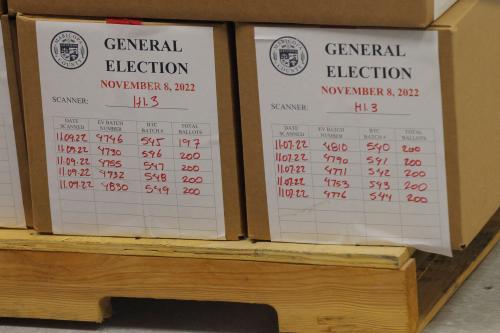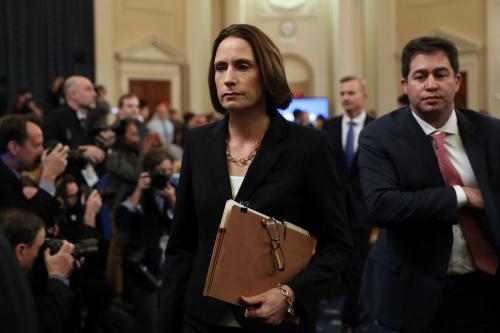The two dozen senior politicians who walk the halls of Zhongnanhai, the compound of the Chinese Communist Party’s leadership in Beijing, are worried. What was inconceivable a year ago now threatens their rule: an economy in freefall. Exports, critical to China’s searing economic growth, have plunged. Thousands of factories and businesses, especially those in the prosperous coastal regions, have closed. In the last six months of 2008, 10 million workers, plus 1 million new college graduates, joined the already gigantic ranks of the country’s unemployed. During the same period, the Chinese stock market lost 65 percent of its value, equivalent to $3 trillion. The crisis, President Hu Jintao said recently, “is a test of our ability to control a complex situation, and also a test of our party’s governing ability.”
With this rapid downturn, the Chinese Communist Party suddenly looks vulnerable. Since Deng Xiaoping initiated economic reforms three decades ago, the party’s legitimacy has relied upon its ability to keep the economy running at breakneck pace. If China is no longer able to maintain a high growth rate or provide jobs for its ever growing labor force, massive public dissatisfaction and social unrest could erupt. No one realizes this possibility more than the handful of people who steer China’s massive economy. Double-digit growth has sheltered them through a SARS epidemic, massive earthquakes, and contamination scandals. Now, the crucial question is whether they are equipped to handle an economic crisis of this magnitude—and survive the political challenges it will bring.
This year marks the 60th anniversary of the People’s Republic, and the ruling party is no longer led by one strongman, like Mao Zedong or Deng Xiaoping. Instead, the Politburo and its Standing Committee, China’s most powerful body, are run by two informal coalitions that compete against each other for power, influence, and control over policy. Competition in the Communist Party is, of course, nothing new. But the jockeying today is no longer a zero-sum game in which a winner takes all. It is worth remembering that when Jiang Zemin handed the reins to his successor, Hu Jintao, in 2002, it marked the first time in the republic’s history that the transfer of power didn’t involve bloodshed or purges. What’s more, Hu was not a protégé of Jiang’s; they belonged to competing factions. To borrow a phrase popular in Washington these days, post-Deng China has been run by a team of rivals.
This internal competition was enshrined as party practice a little more than a year ago. In October 2007, President Hu surprised many China watchers by abandoning the party’s normally straightforward succession procedure and designating not one but two heirs apparent. The Central Committee named Xi Jinping and Li Keqiang—two very different leaders in their early 50s—to the nine-member Politburo Standing Committee, where the rulers of China are groomed. The future roles of these two men, who will essentially share power after the next party congress meets in 2012, have since been refined: Xi will be the candidate to succeed the president, and Li will succeed Premier Wen Jiabao. The two rising stars share little in terms of family background, political association, leadership skills, and policy orientation. But they are each heavily involved in shaping economic policy—and they are expected to lead the two competing coalitions that will be relied upon to craft China’s political and economic trajectory in the next decade and beyond.
One thing is for sure: They have the profoundly difficult task of quickly and effectively transforming the country’s long-standing model of export-led development. That task will require a delicate balance of innovative reforms, further market liberalization, and occasionally, strong government intervention to reshape China’s economy into one driven largely by domestic demand. It is a daunting challenge, particularly when the men at the helm differ so profoundly. There are bound to be power struggles. But there is also a good chance that these everyday rivals, understanding that the party’s survival hangs in the balance, will put aside infighting to guide China out of the crisis.
The team of rivals arrangement is not a choice, but a new necessity for the Chinese leadership. In elevating both Xi and Li in 2007, Hu signaled the importance of the different constituencies each represents and the belief that only consensus-building will successfully forestall serious political upheaval in the so-called fifth generation of leaders, of which Xi and Li are members. The idea of turning rivals into allies “for the sake of the greater good,” as Abraham Lincoln put it, has been widely cited in the Chinese media. A recent article published in China Youth Daily, one of the most popular newspapers in the country, called the “team of rivals” (zhengdi tuandui) a “brilliant idea to achieve political compromise in order to maximize common interest and political capital for survival.”
The two groups can be identified as the “populists” and the “elitists.” The populists are currently led by President Hu Jintao and Premier Wen Jiabao. Members of their core group, including Li Keqiang, Director of Party Organization Li Yuanchao, and Guangdong Party Secretary Wang Yang, are known as tuanpai, after the Chinese Communist Youth League through which they advanced their careers. Most tuanpai—they now make up 23 percent of the Central Committee and 32 percent of the Politburo—served as local and provincial leaders, often in poor inland provinces, and many have expertise in propaganda and legal affairs. President Hu is himself a tuanpai, and the leaders of this faction are widely regarded as his longtime confidants; most of them worked directly under Hu in the early 1980s, when he headed the youth league. Tuanpai are known for their organizational and propaganda skills, but they are lacking when it comes to handling the international economy. Their credentials weren’t as highly valued in the Jiang Zemin era, when foreign investment and economic globalization were stressed above all else, but they are considered critical now as the risks of social unrest and political tensions increase.
The elitist coalition was born in that Jiang era, and though its two current leaders—Wu Bangguo, chairman of the national legislature, and Jia Qinglin, head of a national political advisory body—are little known outside China, they are among the country’s highest-ranking political leaders. Members of the core group of the fifth generation elitists, including Xi Jinping, Vice Premier Wang Qishan, and Chongqing Party Secretary Bo Xilai, are known as princelings because they are the children of former high-ranking officials. The fathers of Xi, Wang, and Bo, for example, all once served as vice premiers. Princelings command 28 percent of the seats in the Politburo today. Most princelings grew up in the richer coastal regions and pursued careers in finance, trade, foreign affairs, and technology. Although patron-client ties are not always strong among the princelings themselves, the shared need to protect their interests, especially in a time of growing public resentment against nepotism, is what binds them together.
Of the six members of the fifth generation serving on the Politburo today, three are tuanpai and three are princelings. The policy differences between these factions are as significant as the contrasts in their backgrounds. To a great extent, their differences reflect the country’s competing socioeconomic forces: Princelings aim to advance the interests of entrepreneurs and the emerging middle class, while the tuanpai often call for building a harmonious society, with more attention to vulnerable social groups such as farmers, migrant workers, and the urban poor.
The platforms of Xi Jinping and Li Keqiang, for example, are strikingly divergent. Xi’s enthusiasm for market liberalization and the continued development of the private sector is well known to the international business community. Not surprisingly, his primary policy concerns include making the economy more efficient, keeping GDP growth high, and deepening China’s integration into the world economy. Xi is particularly interested in keeping wealthy elites in China’s eastern coastal region happy.
By contrast, Li Keqiang is more concerned about the plight of the country’s unemployed. He has made affordable housing more widely available and understands the importance of developing a rudimentary social safety net, beginning with the provision of basic healthcare. The rejuvenation of the northeastern provinces, China’s old industrial base and one of its most labor-intensive areas, appears to be Li’s regional focus. For Li, reducing economic disparities is far more urgent than enhancing economic efficiency. These diverging policy priorities between Xi and Li will likely grow in importance as the men respond to pressing economic questions, such as how China should react to foreign pressure on the value of the yuan and how the government should proceed with its stimulus plan.
Despite their many differences, the fifth generation of tuanpai and princelings share a common trauma: They are part of China’s “lost generation.” Born after the founding of the People’s Republic, they were teenagers when the Cultural Revolution broke out in 1966. They lost the opportunity for formal schooling as a result of the political turmoil, and many of them were the “sent-down youths,” young men and women who were moved from cities to rural areas and who worked for many years as farmers.
Princelings Xi Jinping and Wang Qishan were sent from Beijing to Yanan, in Shaanxi Province, where they spent years on farms. Tuanpai Li Keqiang and Li Yuanchao labored in some of the poorest rural areas in Anhui and Jiangsu provinces. Such arduous and humbling experiences forced these future leaders to cultivate certain traits, such as endurance, adaptability, foresightedness, and humility. They not only had the unusual opportunity to come to know rural China, but they also had to adjust to a completely different socioeconomic environment. This adjustment forced them to learn at an early age how to handle challenges and how to compromise. Xi Jinping recently told the Chinese media that his time in Yanan was a “defining experience,” a “turning point” in his life.
If there is another event that approaches the importance of the Cultural Revolution in the lives of these men, it is undoubtedly the Tiananmen Square incident in 1989. We don’t have much information about how the incident affected them individually, but they are a generation older than many of the protesters, and at the time, several were municipal leaders or chiefs of the youth league. It is clear that they appreciate, as a group, that China’s leadership during Tiananmen was deeply divided over how to respond to the unrest. They also realize that the internal struggle aggravated the crisis and ultimately culminated in a brutal response.
These events taught the fifth generation two lessons: First, they must maintain political stability at all costs, and second, they should not reveal their fissures to the public. Although these leaders wear their differences on their sleeves, there is solidarity at the highest level, inspired by past unrest, to avoid any sign of a split in the leadership, which would be dangerous for the party and for the country.
So, what do these profound differences and influential shared experiences tell China watchers about how the next generation will steer the Chinese economy? The economic prowess of the princelings will be essential to responding to the macroeconomic challenges the country will face this year and beyond. And the sensibilities of the tuanpai, versed as they are in organization and propaganda, will be invaluable as China responds to social problems born of—and exacerbated by—economic stagnation.
The rise of the team of rivals arrangement may result in fewer policies aimed at maximizing GDP growth rates at all costs. Instead, it might give way to policies that provide due consideration to both economic efficiency and social justice. Already, the ongoing global financial crisis has driven the leadership to change its emphasis from export-led growth to encouraging domestic demand, which means addressing rural needs. An ambitious land reform plan, which was adopted in the fall of 2008, promises to give farmers more rights and market incentives to encourage them to subcontract and transfer land. This strategy aims to increase the income of farmers, reduce economic disparity, promote sustainable urbanization, and ultimately end the century-long segregation between rural and urban China. Some analysts think that this land reform, along with a nearly $600 billion stimulus plan announced in November that favors railroad construction and rural infrastructure development, will greatly boost the country’s domestic economy and hopefully propel China through the current economic crisis.
Although the land reforms largely reflect President Hu’s agenda and the influence of the populists, leaders from the elitist camp have also been supporters of these policy initiatives. Political compromise and consensus-building, not zero-sum factional infighting, have shaped the rural development and stimulus plans.
But China’s new game of elite politics may fail. What will happen, for instance, if economic conditions continue to worsen? Factionalism at the top might grow out of control, perhaps even leading to deadlock or outright feuding. Different outlooks over many issues—including how to redistribute resources, establish a public healthcare system, reform the financial sector, achieve energy security, maintain political order, and handle domestic ethnic tensions—are already so contentious that the leadership might find it increasingly difficult to build the kind of consensus necessary to govern effectively.
Barring something entirely unexpected, though, the populist policy platform will prevail over the next three to four years, and the ongoing global financial crisis will likely push Chinese leaders to increase government intervention in the economy. Yet there may be a swing in the opposite direction in 2012 as princeling Xi Jinping succeeds Hu Jintao, similar to the transition from Jiang to Hu. The establishment of such shifts during transitions at the top can create a healthy political dynamic that prevents one faction from wielding excessive power. Because of new leaders’ differences in expertise, credentials, and experiences, contending coalitions will realize that they need to find ways to coexist in order to remain in power. They do, after all, have a common interest in social stability and the shared aspiration to further China’s rise on the world stage. Given China’s long history of arbitrary decision-making by one individual leader, this “one party, two coalitions” practice represents a major step forward—for the party and the people.



Commentary
China’s Team of Rivals
February 17, 2009